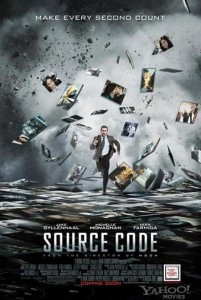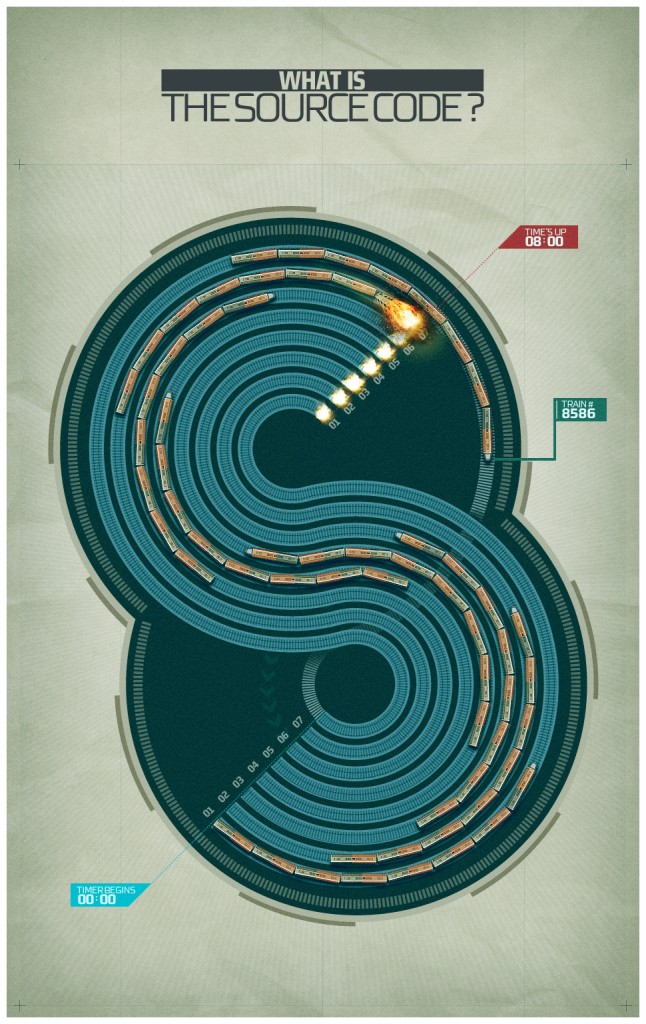Sometime you get thrown a very badass interview that you didn’t expect, and it ends up being one of the best you’ve ever done. This is definitely one of those cases, where the sharp folks behind the marketing for Source Code decided it would be a good idea to recruit a legit neuroscienctist to speak with me about the science of Duncan Jones’ latest, the potential implications of those kinds of technologies, and the general role science fiction plays in inspiring actual science. I’m glad they did, because I very much enjoyed Source Code and feel it’s a film well worth talking about.
Dr. Charles Higgins is a guy doing some pretty cutting edge stuff. An associate professor in the department of Neuroscience and the department of Electrical and Computer Engineering, he is working on the kind of technology that could one day blossom into the real-life versions of machines seen in Source Code, The Matrix and countless other science fiction films. From his bio…
“My laboratory conducts research in areas that vary from computational neuroscience to biologically-inspired engineering. The unifying goal of all these projects is to understand the representations and computational architectures used by biological systems, which are quite different from (and in many cases functionally superior to) conventional engineering systems. These projects are conducted in close collaboration with “wet” neurobiology laboratories who perform anatomical, electrophysiological, and histological studies, mostly in insects.”
Which is to say, if his calculations are correct, when his research progresses far enough… you’re gonna see some serious shit.
There’s a ton of interesting discussion here, which I recorded via Google Voice yesterday. Due to the limited time frame I had to turn this around, I decided to leave some portions of the interview as audio clips that you can listen to, while I made sure to transcribe the discussions that directly related to Source Code, or that were of particular interest. The un-transcribed audio clips are all summarized, and all of the clips should be accessible via clearly marked link. If you have the luxury, I would suggest listening to all 9 parts, as it’s interesting to hear the doc articulate his thoughts.
Naturally a discussion of this kind brings up the conceptual conceit of the film, which could be considered a spoiler. These ideas are brought up fairly early in the film but if you’re very spoiler-sensitive or feel like you’re still totally in the dark even after the trailer, then hang on to this and come back when you’ve seen it. There is one answer that does discuss events at the end of the film, and that clip has been separately marked, and the doctor’s spoiler warning left in the audio just in case.
Enjoy the talk, and make sure you mention it to your friends and link it around. I’m hoping for a good response to this interview, as it might inspire the studios to be this creative in their marketing more often. I love being empowered to bring you guys special content!
——————————
“Tell me about your research focus and about your day-to-day experiments…”
AUDIO: Dr. Higgins on SOURCE CODE – Part 1 (transcribed below)
“I spent quite a few years trying to build silicon devices that were mimicking brains, whether that would be an insect brain, or a rat brain, or a human brain. And it occurred to me one day that the silicon creations I was making were costing a lot than the original brains themselves. I was mimicking a section of a fly brain and the silicon device I was fabricating was costing me around sixty-thousand dollars, and how much can a fly brain cost? A buck? Fifty cents? Twenty cents? So I started to get the idea- what if we could use and existing brain as a sensor for a robot or as some sort of processing unit. Rather than building something artificial, can I interface something artificial with something alive?
So we started off with a hawk moth, which is a rather large moth and I thought it would be kind of hard to kill. So we interfaced with its brain and with some of its muscles and put that on board a robot and tried to use its visual system to control a robot, and we had moderate success with that because in order to maintain contact with the brain while the robot is moving, it turned out to be quite difficult. The neurons are pretty small, and we had to keep a sharp electrode pretty close to one of those neurons while the robot was driving around, and that turned out to be difficult.
So what we’re doing now is I’m working with dragonflies- they have this amazing ability to track small moving targets so they’ll be perched someplace, there’s a mesquite that flies by at a really high speed and they can take off and catch it. So, instead of getting directly into the brain we’re tapping into the spinal cord of dragonflies, and what I’m interested to do is to get as much information about the visual system from the dragonfly’s nerve cord as I can. And what I would like to be able to do is record real-time information from the dragonfly’s spinal cord, interpret what the dragonfly saw, and use that to steer a robot towards what the dragonfly saw. So the dragonfly’s brain and nervous system becomes a living visual sensor for a robot. So that’s the sort of idea that I’m interested in.”
“Explain to me how you reconcile the information your receiving from the insect brain, with whatever programming language is required to run a given computer or robot- how does that communication occur?”
AUDIO: Dr. Higgins On SOURCE CODE – Part 2 (on organic/robotic communication)
Dr. Higgins explains that the information pulled from the insect is purely visual, and controls a robots that does not require a programming language to sync up. The two are “completely different orthogonal paradigms.” Also, he explains how organic brains and computers have different and complementary strengths and weaknesses.
“I’m not sure what kind of movie fan you are, or what your usual relationship with film is, but tell me about your experience watching a film like Source Code, that crosses over into your field…”
AUDIO: Dr. Higgins on SOURCE CODE – Part 3 (transcribed below)
 “I have two experiences, two responses.. One, as a movie viewer, I enjoyed it- it’s my kind of movie, it just happens to be my kind of thing. Secondly, as a scientist, whenever I see a movie like this, my mind goes to work on how to make it work, how to build it. I want to figure out how it all worked, and what machines are required in order to do it. And as a scientist, I really take a lot of inspiration from science fiction because people who are writing this stuff have no idea what’s possible and what’s not- they’re not limited by the knowledge I have of what’s available, and what I don’t think will ever be available. See what I mean?
“I have two experiences, two responses.. One, as a movie viewer, I enjoyed it- it’s my kind of movie, it just happens to be my kind of thing. Secondly, as a scientist, whenever I see a movie like this, my mind goes to work on how to make it work, how to build it. I want to figure out how it all worked, and what machines are required in order to do it. And as a scientist, I really take a lot of inspiration from science fiction because people who are writing this stuff have no idea what’s possible and what’s not- they’re not limited by the knowledge I have of what’s available, and what I don’t think will ever be available. See what I mean?
So, I find it really interesting to see what people would imagine if they’re not limited, and I really think this is a good example. There are some jumps in this movie that I find very hard a scientist to figure out how that could happen, and that makes it all the more interesting for me.”
“What concepts in Source Code struck you intellectually?”
AUDIO: Dr. Higgins on SOURCE CODE – Part 4 (transcribed below)
“Scientists, especially older scientists, tend to be really limited by whats possible. When I was 20, I had all these ideas about all this crazy stuff I was gonna build, and now that I’m double the age and more, I tell students on a regular basis, “I don’t see in my lifetime ever being able to do that.” So, for example in Source Code, we’re talking about transferring consciousness from place to place, we don’t even know what it is. Okay, so if a student comes to me with a project and says, ‘I want to transfer consciousness.’ I’m going to tell him, ‘that’s not possible and probably your grandchildren are going to think it’s still not possible.’
On the other hand, there’s some writer in Hollywood who came up with the idea completely unlimited by what they think is possible or impossible and it’s a really interesting concept. So, is there anything to that? What do we mean by consciousness? And if you could transfer that consciousness –forget the time travel aspects– if you could just transfer the consciousness of a person into a computer, that would be huge. Even a portion of the consciousness. Even the memories, Even some aspect of the personality, or something that would be unique to the person. That would be amazing. We’re not anywhere close to that because we don’t’ know what it means- whatever this element was that was transferred from Jake Gyllenhaal’s character into somebody in the last eight minutes of their life, whatever that thing was- that’s what I’m calling consciousness. We don’t know where it resides, what exactly it is, does it persist after death..? I mean, there’s a lot of argument about that.”
“Tell me what you feel is the most plausible aspect of the science of Source Code, what you feel we could actually see.”
AUDIO: Dr. Higgins on SOURCE CODE – Part 5 (transcribed below)
“Well, the most prosaic, the most likely thing is that you could take somebody whose brain was alive but whose body was non-functional, for whatever reason, and give them some sort of experience that would be akin to –although not probably as complete as– their real experience. So you might be able to hook up some advanced neural interface that’s well beyond our technology today and give them some experience where they could perhaps interact with people and they could have a visual experience. Probably not a whole-body sensory experience, but that’s the most possible aspect, that I could see coming in, I dunno, maybe 100 years? Something like that. Before we could do that, we’ll be more likely to have prosthetics that you can hook up to the functional body and make the prosthetics work with the real body rather than giving the brain a simulated experience. You see what I mean? I think the prosthetics are going to come first on the real bodies, some sort of semi-bionic man repair, before the point that we could give a whole sensory experience to the brain.”
“What sort of timeline do you think these technologies are on- how long before they would affect someone’s day-to-day life?”
AUDIO: Dr. Higgins on SOURCE CODE – Part 6 (predicting technologies that exist vs. serendipity of accidental discovery -&- why he doesn’t fear a Skynet situation)
Here Dr. Higgins explains that while neurally-controlled prosthetics already exist in some form and can easily be predicted to be common within a few decades, technologies like advanced neural interfaces will likely be the result of accidental breakthroughs or unexpected discoveries and are much harder to predict. He also assuages my fears of computers becoming both sentient and malevolent, before scaring the shit out of me with the much more likely scenario of advanced military hardware simply malfunctioning.
 “Are there other movies that as a scientist, as a technician that inspire you, or strike you?”
“Are there other movies that as a scientist, as a technician that inspire you, or strike you?”
AUDIO: Dr. Higgins on SOURCE CODE – Part 7 (the films and television that have inspired him, and scientists in general)
Here Dr. Higgins describes some of the film that inspired him, including the original Star Trek, Terminator, and even General Grievous of the Prequel trilogy! He talks about how many of our great scientific achievements were clearly inspired by the science fiction of the 60s or earlier, even discussing some specific technologies.
“So there are some potential ethical questions raised by shifting consciousness that we’ll have to face. Do you encounter any of those issues in your own work, or do you feel like it will be some time before we have to cross that bridge?”
AUDIO: [SPOILERS] Dr. Higgins on SOURCE CODE – Part 8 (on the ethical issues of neural science)
Here Dr. Higgins outlines a potential ethical diemma stemming from the military development of these technologies- which might force young soldiers to be involved in risky procedures and experiment in order to remain cutting edge. He also discusses how his own work focuses on animals with little or no consciousness, but the moral issues increase as your test subject’s potential mental cognition increases.
“What do you gain from a process like this, and would you be interested in advising movies in the future?”
AUDIO: Dr. Higgins on SOURCE CODE – Part 9 (transcribed below)
“This is just good fun for me, I like to talk about science and talking at that level of imagination is really good for somebody like me who is in the business of creativity. I really need to push beyond the boundaries of what is possible today and figure out what I’m supposed to be doing, and this is a great way for me to do it. To talk with somebody who’s a non-scientist and have to explain it in terms that makes sense to everybody- that’s a great way for me to think about what the heck I’m supposed to be doing, and what I should be doing in five years and ten years. If I can’t explain to you what I’m doing, why it makes sense- should I be doing it? Maybe it doesn’t make any sense, maybe it has no purpose. See what I mean? There’s an old saying among researchers that, if you can’t explain what you’re doing to your grandma, then it is probably not worth doing.”
DISCUSS THIS on the CHUD Message Board
&
Like / Share it on Facebook (above or below) if you think it’s great!
